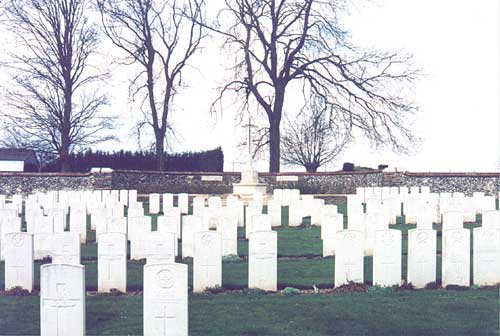|
Details
Contalmaison is a village and commune
in the Department of the Somme, 6 kilometres North-East of Albert and
the Château Cemetery is within the Château grounds on the
North side of the main street.
The village was reached on 1st July,
1916, by small parties of the 34th Division. It was stormed by the 23rd
Division on the 7th July, and some men of the Northumberland Fusiliers
taken four days earlier were released, but it was lost the same afternoon,
and it was not finally captured until the 8th and 9th Yorkshire Regiment
cleared it on the 10th. It was lost again in March, 1918, and recaptured
by the 38th (Welsh) Division on the evening of the following 24th August.
The underground fortifications made by the Germans before 1916 played
an important part in the defence of the village.
The Cemetery was begun by fighting
units on the eveneing of the 14th July, 1916, and used from September,
1916 to March, 1917 by Field Ambulances. A few burials were made in
Plot I, Rows B and C, in August and September, 1918. Forty seven graves
were added after the Armistice by concentrations from battlefields of
the Somme and the Ancre, and 18 German graves and 1 French were removed
to other burial grounds. The Cemetery now contains the graves of 264
soldiers from the United Kingdom, 21 from Australia, four from Canada.
The unnamed graves are 48 in number, and a special memorial is erected
to one soldier from Australia known to buried among them.
Number of burials by unit
| Royal Field Artillery
|
23
|
|
Australian burials
|
21
|
| Royal Army Medical
Corps |
15
|
|
Cameron Highlanders
|
14
|
| Gordon Highlanders
|
10
|
|
Northamptonshire Regiment
|
10
|
| Northumberland Fusiliers
|
10
|
|
Welsh Regiment |
10
|
| Cameronians
- Scottish Rifles |
9
|
|
Highland
Light Infantry |
9
|
| Royal Scots - Lothian
Regiment |
9
|
|
Durham Light Infantry
|
8
|
| Argyll & Sutherland
Highlanders |
7
|
|
Gloucestershire Regiment
|
7
|
| Black Watch |
6
|
|
King's Own Scottish
Borderers |
6
|
| Royal Engineers |
6
|
|
Royal Garrison Artillery
|
6
|
| Royal Scots Fusiliers
|
6
|
|
Machine Gun Corps
|
5
|
| Royal Welsh Fusiliers
|
5
|
|
South Welsh Borderers
|
4
|
| York & Lancaster Regiment
|
4
|
|
Canadian burials |
3
|
| Duke of Wellington
- West Riding Regiment |
3
|
|
Green Howards - Yorkshire
Regiment |
3
|
| Loyal North Lancashire
Regiment |
3
|
|
Royal Warwickshire
Regiment |
3
|
| Royal Army Service
Corps |
2
|
|
Royal Irish Rifles
|
2
|
| Seaforth
Highlanders |
2
|
|
West Yorkshire
Regiment |
2
|
| 6th Dragoon Guards
|
1
|
|
Duke of Cornwall Light
Infantry |
1
|
| King's Own Yorkshire
Light Infantry |
1
|
|
London Regiment -
14th Bn. London Scottish |
1
|
| Middlesex Regiment
|
1
|
|
Nottinghamshire &
Derbyshire Regiment |
1
|
| Oxfordshire & Buckinghamshire
Light Infantry |
1
|
|
Royal Berkshire Regiment
|
1
|
| Royal Sussex Regiment
|
1
|
|
South Staffordshire
Regiment |
1
|
| Worcestershire Regiment
|
1
|
|
|
|
| Identified burials
|
244
|
|
|
|
| Unidentified UK
burials: |
44
|
|
|
|
| Unidentified Canadian
burials: |
1
|
|
|
|
| Wholly Unidentified |
3
|
|
|
|
| Total Unidentifed |
48
|
|
|
|
| Total burials |
292
|
|
|
|
Awards
L/Cpl. A. English D.C.M., 24th
(Tyneside Irish) Bn. Northumberland Fusiliers. Died 4th Sept. 1916.
II. B. 4.
Cpl. C. How M.M., "A"
Bty. 72nd Brig. Royal Field Artillery, died 1st Dec. 1916 aged 24. I.
D. 14.
Pte. J. Johnson M.M., 8th Bn.
Seaforth Highlanders. Died 17th Oct. 1916. I. C. 7.
Capt. Arthur Lloyd Jones M.C.,
14th Bn. Royal Welsh Fusiliers. Died 3rd Sept. 1918 aged 35. I. C. 29.
Cpl. J. Mackay D.C.M., 6th/7th
Bn. Royal Scots Fusiliers. Died 10th Aug. 1916. II. A. 29.
L/Cpl. S. Roper D.C.M., 1st/7th
Bn. Worcestershire Regiment. Died 13th Nov. 1916. I. C. 20.
|
|
|
Pte. William
Henry Short V.C., "C" Coy. 8th Bn. Yorkshire Regiments,
the Green Howards.
Died of wounds 7th Aug. 1916 aged 31. Son of James and Anne Short
of 35 Vaughan Street, Grangetown, Yorkshire. Born at Eston, Yorkshire.
An extract from 'The London Gazette,' No. 29740 dated 8th Sept.
1916 records the following:- "For most conspicuous bravery.
He was foremost in the attack, bombing the enemy with great gallantry,
when he was severely wounded in the foot. He was urged to go back,
but refused and continued to throw bombs. Later his leg was shattered
by a shell, and he was unable to stand, so he lay in the trench
adjusting detonators and straightening the pins of bombs for his
comrades. He died before he could be carried out of the trench.
For the last eleven months he had always volunteered for dangerous
enterprises, and has always set a magnificent example of bravery
and devotion to duty"
II. B. 16. |
|
